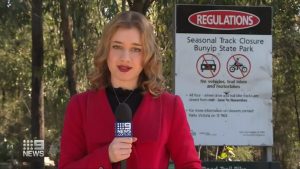When bushfires hit Mallacoota this past summer two regional news services covered them very differently.
WIN News Gippsland pushed its reporters to make the four-hour round trip from their offices in Traralgon to East Gippsland to cover the fires while also filing separate soft news pieces. While Nine News Gippsland mostly handed the story to journalists from the Melbourne newsroom instead of their local reporters
The different approaches highlight the dual challenges facing regional broadcast media with resources dwindling and media ownership laws having been relaxed.
A daily race against time
Extending from Melbourne’s eastern suburbs to the New South Wales border, Gippsland is a vast region to cover.
With two to three stories to produce per day, a minimum of two on-camera talent required for each story and travel times of up to two hours between newsrooms and some locations, local TV journalists face a daily race against time to fill their bulletins.

Bonnie Barkmeyer reporting for WIN News. For Barkmeyer it’s her first full-time job out of university and a great training ground. (WIN News Gippsland)
For WIN News Gippsland reporter Bonnie Barkmeyer says it’s her first full-time job out of university and a great training ground.
“We pretty much do it all between myself and the cameraman,” Barkmeyer says.
“We find the stories, do the interviews, all the filming, come back, I’ll go through the grabs myself, choose the right grabs that I want, research and find the right information and then write up the story. We do it all.”
Nine News Gippsland reporter Nadia Dimattina follows a similar process.
“It’s a pretty small team. We have two cameramen and three journos,” Dimattina says.
“On a normal day pre-COVID we’d have to collect three news stories a day and a VO slot which is just a short version with a grab in it and then we needed to file two sports stories.”
Both stations are located in Traralgon near the region’s centre, and while they have different resources and relationships with their metropolitan counterparts, the challenges they face in covering the area are similar.
“It’s pretty full-on. I did a bit of casual reporting in Bendigo and Ballarat before I started in Gippsland and I found that in those towns everything would be in the towns of Bendigo and Ballarat and there wouldn’t be huge drives,” Dimattina says.
“But then I moved to Gippsland and every day we’d be driving, sometimes up to two hours, to get to a story because it’s such a huge area.”
At WIN, there’s no capacity to edit on the road, so Barkmeyer’s expected to shoot her stories then compile them back at the office.
“It would be really good if we had up to date resources in terms of technology that allow us to file from the road,” Barkmeyer says.
“I’m having to take my personal laptop and write because we don’t have work laptops.”
While the Nine team do have the ability to file from the road, the program they use to write scripts requires internet and Gippsland has poor reception.
“When internet drops out you can’t write and you sometimes lose your script and it’s just a disaster,” Dimattina says.
Small newsrooms covering vast areas have become more common since a relaxation of media rules in 2017 which abolished the two out of three and 75 per cent audience reach rules for companies.
RMIT Professor of Digital Communication Lisa Waller says this means “things will be missed”.
“If you look at any of the ACMA maps for local broadcasting areas, basically what they’re calling a local area is huge,” Waller says.
“There’s a greater reliance then on media statements, press releases, other forms of media subsidies that people can provide.”
Mallacoota bushfires
When Mallacoota in Gippsland’s east was ravaged by bushfires this past summer, Barkmeyer felt the stress on WIN’s resources.
“Because we’re based in Traralgon and the bushfires were at least two hours away, we were having to go down there every day, report on the latest news – so that’s two hours there and two hours back,” Barkmeyer says.
“So we were in the car for at least four hours reporting on the latest news with bushfires and then having to do another story to fill our bulletin.”

Nadia Dimattina reporting for Nine News Gippsland. For Dimattina covering Gippsland is “pretty full-on. (Nine News Gippsland)
Over at Nine the channel’s relationship with its metropolitan newsroom meant Dimattina didn’t cover the fires quite like the reporters at WIN.
“During the bushfires when all the things happened in Mallacoota they [Nine News Melbourne] sent out their own metro journalists and they basically covered the bushfires themselves,” Dimattina says.
“So that was a bit disappointing because we were on the ground in Gippsland, but we couldn’t really cover it because metro were covering it.”
Professor Waller calls this “parachute journalism”.
“Those communities in places like Mallacoota, you know that’s not going to be over and done with by the end of COVID-19 or 2023 or 2025,” Waller says.
“And those local journalists at WIN TV and the local Gippsland newspapers and Gippsland ABC will be continuing to tell those stories for that community, and to help them with their recovery.”
Dimattina says some locals asked why Nine Gippsland journalists weren’t covering the fires.
“It made us realise that we are definitely recognised by the community as the regional news and I think that they missed that during that time,” Dimattina says.
Although linear broadcast audiences are steadily declining, for regional areas like Gippsland, TV is still a vital source of news.
“It’s very easy with all the talk about digital and social to think that’s where people are getting their news,” Waller says.
“But your average Australian local commercial television news is a really key part of the information economy, it’s really important.”
COVID-19
Much like the bushfires, the COVID-19 pandemic has seen the two channels adapt in very different ways.
WIN News has embraced programs like Zoom and Skype to fulfil their two talent per story rule and are using social media to source stories.
Barkmeyer says it’s “taken the pressure off of scheduling”.
“We have a lot more time to do our interviews virtually and write our stories rather than taking into account travel time, so that’s positive.”
But over at Nine, there’s currently no bulletin left for Dimattina to contribute to.
“Basically, when COVID came around we were told that the regional bulletin would stop,” Dimattina says.
Two of her colleagues were sent to Melbourne, leaving Dimattina on her own in the newsroom in Gippsland to file updates and social media content.
“I had to be my own newsroom. I was it, basically,” she says.
Nine have turned to social media during the lockdown to distribute stories now that they don’t have a nightly bulletin.
“Our biggest concern was that all of our viewers would turn to WIN because we no longer had a regional bulletin. So I think our only way to keep us kind of present for people to know we were still there was through social media,” Dimattina says.
“And a lot of our stories that we have posted on our Facebook page have gone off. There have been so many likes, the reach has been amazing.”
As for when Nine News Gippsland’s nightly bulletin will return, Dimattina doesn’t know.
“I guess we’ll eventually go back into the newsroom and go back to normal,” Dimattina says.
“But at this stage, Melbourne haven’t changed its newsroom structure yet so until they change their newsroom structure that will have an impact on when we can go back.”
By then the Gippsland media landscape may look quite different.
FEATURED IMAGE: Camera at press conference. When bushfires hit Mallacoota this past summer two regional news services covered them very differently. (Envato)



